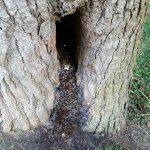Rose Rosette disease in the Knockout Rose is very common viral disease here in SE Virginia now (and I know it is common in other states as well). It is a disease that affects many other roses such as the multifloral, climbing, and even hybrid roses. I have had first hand experience with this rose […]
What is this smelly tar like substance leaking from my Oak tree?
What is this smelly tar like substance leaking from my Oak tree? It is most likely ‘slime flux’ and it is a bacterial disease which in many cases does NOT cause long term or severe damage to the tree. Slime Flux Or Wetwood disease can affect Oaks, Tulip Populars, Elms, and Maples. There is nothing […]





